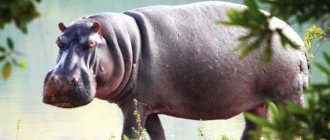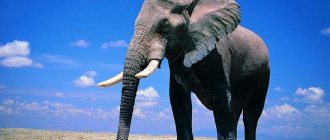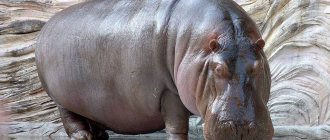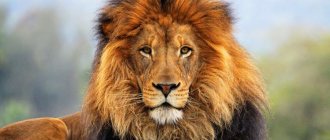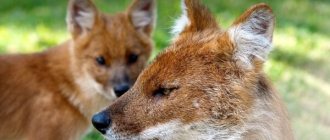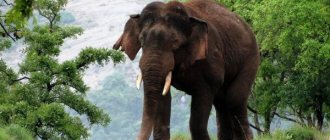African elephants are characterized as the largest living creatures living on land, as well as the second largest animals living on our Planet. As you know, the largest inhabitant of the globe is the blue whale. Among other things, elephants represent the only proboscis animals on the African continent.
Man has always admired the enormous strength, power and behavior of elephants. At first glance, elephants are heavy, clumsy and sometimes lazy creatures. In fact, this is not at all the case; under certain conditions, elephants are capable of displaying the inclinations of intelligence, and can also be fast and agile.
Appearance
Ears
Elephants' ears, in addition to their intended purpose, also act as an air conditioner. In hot weather, elephants wave them, and thereby cool the blood in the ears, which, thanks to numerous blood vessels, cools the entire body of the animal.
Leather
The term "pachyderm" comes from the Greek word "pachydermos", meaning "thick skin". The thickness of the skin on some parts of the body can reach 2.54 cm. The skin does not fit tightly to the body, which creates the appearance of baggy pants. The benefit of thick skin is to retain moisture by increasing evaporation time and keeping the body cool longer. Despite the thickness of their skin, elephants are very sensitive to touch and sunburn. To protect themselves from blood-sucking insects and the sun, they often pour water on themselves and also roll in the mud.
Tusks and teeth
An elephant's tusks are located on the upper jaw and serve as the only incisors. They are used for protection, obtaining food, and also for lifting objects. Tusks are present at birth and are baby teeth that fall out after a year when they reach a length of 5 cm. Permanent tusks emerge from the lips after 2-3 years and grow throughout life. The tusks are made of ivory (dentine), with an outer layer of enamel, and the distinctive shape creates a special shine that distinguishes the tusks of elephants from other mammals such as hippos, warthogs, walruses and sperm whales. African elephants often die at the hands of poachers simply because of their tusks.
Elephants also have molars, located on both jaws on both sides. One molar can weigh about 2.3 kilograms and be the size of a brick. Each elephant changes up to 6 sets of teeth during its life. New teeth do not grow vertically, as in most mammals, but climb from behind, while old and worn ones are pushed forward. In old age, elephants' molars are sensitive and worn down, so they prefer to eat softer food. In this case, swamps are ideal places for soft vegetation to grow. In such areas you can often find old individuals that remain there until their death. This fact has led some people to believe that elephants go to special places to die.
Trunk
The elephant's trunk simultaneously acts as its upper lip and nose. There are 8 large muscles on each side of the trunk, and along its entire length there are about 150,000 muscle bundles (muscle lobes). This unique appendage lacks bone and cartilage. He is so strong that he can pull down a tree trunk and so agile that he can pick up only one straw. Elephants use their trunks like we use our hands: grasping, holding, lifting, touching, pulling, pushing and throwing.
The trunk also serves as the nose. It has two nostrils to suck air through the long nasal passages into the lungs. Elephants use their trunk to drink, but the water does not go all the way to the nose like a straw, instead, it lingers in the trunk and then the elephant lifts its head and pours the water into its mouth.
Ancestors of modern giants
Ancient relatives of proboscis appeared on earth approximately 65 million years ago, during the Paleocene era. At this time, dinosaurs still walked the planet.
Scientists have found that the first representatives lived on the territory of modern Egypt and were more like a tapir. There is another theory, according to which the current giants descended from a certain animal that lived in Africa and almost all of Eurasia.
Research revealing how long the elephant has lived on our planet points to the existence of its ancestors.
- Deinotherium. They appeared approximately 58 million years ago and died out 2.5 million years ago. Outwardly they were similar to modern animals, but were noted for their smaller size and shorter trunk.
- Gomphotherium. They appeared on earth approximately 37 million years ago and died out 10 thousand years ago. Their body resembled the current long-nosed giants, but they had 4 small tusks, twisted in pairs up and down, and a flat jaw. At some stage of development, the tusks of these animals became significantly larger.
- Mamutids (mastodons). Appeared 10-12 million years ago. They had dense hair on their body, long tusks and a trunk. They became extinct 18 thousand years ago, with the advent of primitive people.
- Mammoths. The first representatives of elephants. They appeared from mastodons approximately 1.6 million years ago. They became extinct about 10 thousand years ago. They were slightly taller than modern animals, their body was covered with long and dense hair, and they had large tusks hanging down.
Mammoths belong to the same order of elephants as modern giants.
The African elephant and the Indian elephant are the only representatives of the proboscis order existing on Earth.
Habitat
Asian elephants live in Nepal, India and parts of Southeast Asia. The main habitat is low-growing and tropical forests. During dry months they are often found near river banks.
African bush elephants (savanna elephants) live in eastern, central and southern Africa, preferring lowland and mountain forests, floodplains, all types of wooded areas and savannas. Forest elephants are found in the Congo Basin and western Africa, in moist, semi-deciduous tropical forests.
Video
And in conclusion, an interesting documentary film “The Life of a Family of African Elephants”.
Author: Pavel Chaika, editor-in-chief of Poznavaika magazine
When writing the article, I tried to make it as interesting, useful and high-quality as possible. I would be grateful for any feedback and constructive criticism in the form of comments on the article. You can also write your wish/question/suggestion to my email [email protected] or Facebook, with respect, the author.
Author page
Big appetite
The elephant's diet includes all types of vegetation, from grass and fruit to leaves and bark. Every day these huge animals consume 75-50 kilograms of food, which is 4-6% of their body weight. On average, they spend up to 16 hours a day eating. Savannah elephants are herbivores and feed on grass, including sedges, flowering plants, and leaves of bushes. Forest elephants prefer leaves, fruits, seeds, twigs and bark. Asian elephants have a mixed diet; during dry periods and after heavy rains they eat shrubs and small trees, and after the first part of the rainy season they can eat grass. Also, Asian elephants can eat different types of plants depending on the season, branches and bark.
Nutrition
In order to feed its loved one, an elephant has to get food for itself almost all day. And you need a lot of food - up to 400 kg of green mass in just one day. The elephant uses its trunk to put into its mouth everything that is suitable for food - leaves, branches, herbs, fruits of bushes and trees. Those elephants who live in captivity are especially lucky.
There the animals are fed hay, cereals, fruits and vegetables. Hay is consumed up to 20 kg, and the rest is added with cabbage, carrots, pumpkin, zucchini, and apples. Even on “free bread”, elephants wander into the lands of local peasants to feast on vegetables.
It’s a pity, but very often people who work with elephants in serving tourists or small zoos allow these animals to be fed food that is very harmful to them, for example, sweets. This is strictly contraindicated, but the tourism industry assumes “any whim for your money.”
Life in the herd
Elephants live in close social groups called herds, usually consisting of females and their offspring. The main leader of the herd is the most experienced and mature female, so matriarchy reigns in the elephant family. The leader of the herd remembers how to find the way to food and water, while avoiding predators, and knows the best places to hide. Also, the main female has the right to teach younger individuals the rules of behavior in society. In some cases, the group may consist of one of the main leader's sisters and her offspring. When the number of individuals in a group becomes large, a new herd is formed, and they can maintain free communication with other associations.
Adult males do not usually live in a herd. After gaining independence from their mother, males leave the herd and live alone or with other bachelors. Males can visit a herd of females only for a short time, for reproduction. They do not participate in raising their offspring.
Etiquette is an important component of elephant society. The trunk may be extended to another elephant as a greeting, to show affection, to hug, during wrestling, and to check reproductive status.
Offspring
At birth, a baby elephant is about a meter tall and weighs 55-120 kg. As a rule, babies are born with hair, a short trunk and are directly dependent on the mother and other members of the herd. They do not need a trunk, since milk from the mother goes into the mouth. Baby elephants try to stay as close as possible to their mother or another nursing female. During the first year of life, on average, they gain 1-1.3 kilograms of weight per day. If the baby is in distress, other members of the herd often come to his aid.
Despite prolonged gestation and protection, elephant calves need to gradually move up the social levels of the herd and establish their position in it. The cubs spend their days learning to walk on four legs in one direction, trying to cope with huge ears and mastering the work of their trunks. At first they are very clumsy, but all the time they learn to control their body. Upon reaching 2-3 years of age, elephant calves stop feeding on their mother's milk.
Reproduction
Elephants live in family herds, with an average of 9-12 individuals, where the leader is the oldest female. Yes, matriarchy reigns in the elephant family. Female elephants reach sexual maturity at 12-14 years of age (exactly like humans), and by the age of 16, a female elephant is already capable of bearing cubs.
As for the males, after they reach sexual maturity at the age of 15-20 years, they leave their native herd and become single elephants. During certain mating periods, sensing that the females are ready to mate, the male elephant approaches the herd and begins courting the female elephant he likes. During this period, clashes often arise between male elephants, and then the desired female elephant goes to the strongest suitor.
An elephant's pregnancy lasts 20-22 months; childbirth takes place in the company of other females from the herd, who carefully surround the mother and newborn baby, protecting them from accidental danger. Usually only one baby elephant is born, in very rare cases there may be twins. A born elephant calf usually weighs about a hundredweight. The baby elephant develops very quickly, within a month he walks and sucks his mother's milk, travels with his relatives, grabbing his mother's tail with his trunk. Until two years old, elephant calves are fed with their mother's milk, and, interestingly, not only its mother, but also another lactating elephant can feed the baby elephant.
Enemies
What animals pose a threat to elephants? Not many! Baby elephants can become potential food for hyenas, lions, leopards or crocodiles, but as long as they are close to their mother, there is no need to worry. If the elephant senses approaching danger, it makes a loud sound (alarm) to warn others. To combat a potential predator, the herd forms a protective ring of adults, with the babies in the middle. For an adult elephant, the main enemy is a poacher with a rifle.
Interesting Facts
Monkeys are included in the list of the most intelligent animals on the planet, they have an excellent memory, remember grievances and places of important events, have empathy, developed emotional experiences, are able to be happy, sad, and empathize with their loved ones.
Sounds
Elephants make many different sounds, but human ears cannot detect some of them because they are low-frequency. Elephants use these sounds to communicate with each other over long distances. Have you ever had your stomach growl at the most inopportune moment? For the elephant community, this is a welcome sound that signals to other elephants that “everything is okay.”
African elephant
Security status: Vulnerable. Listed in the Red Book of the International Union for Conservation of Nature
African elephants are the world's largest land animals. Their trunk is an extension of the upper lip and nose and is used for communication with other individuals, handling objects and for eating. African elephants, unlike Asian ones, have two branches at the end of their trunk. Tusks, which grow throughout life, are observed in both males and females, and are used in fighting, for digging, and also for food. Another notable feature of African elephants is their huge ears, which help cool their huge bodies.
Today there are two types of African elephants:
Savannah or bush elephant (Loxodonta africana);
Forest elephant (Loxodonta cyclotis).
The savannah species is larger than the forest species and has tusks curved outward. At the same time, the forest elephant is darker in color with straight, downward-pointing tusks. There are also differences in the size and shape of the skull and skeleton.
Social structure
The social structure of elephants is organized around a herd consisting of related females and their offspring. In the savanna elephant, each family unit includes about 10 individuals, although there are also associations of these family units - “clans”, which can number 70 individuals. Forest elephants live in small family groups. Herds can form temporary aggregations of elephants, numbering around 1,000 individuals, mainly in East Africa. These associations arise during periods of drought, due to human intervention or any other change that worsens the standard pattern of existence. When threatened, elephants create a ring around the young and the matriarch (the main female), which can be attacked. Young elephants stay with their mother for many years and also receive care from other females in the herd.
Life cycle
As a rule, a female gives birth to one cub, once every 2.5-9 years, at the beginning of the rainy season. Pregnancy lasts 22 months. Cubs are breastfed for 6-18 months, although there are cases of feeding up to 6 years. Males leave the female after mating and typically form alliances with other males. The lifespan of African elephants can be 70 years. The fertile age of females begins at 25 years and lasts up to 45 years. Males need to reach 20 years of age to successfully compete for a female with other males.
Diet
African elephants prefer to eat leaves, branches of bushes and trees, but can eat grass, fruits and bark.
Historical habitat and population size
The African elephant's habitat ranged across most of Africa, from the Mediterranean coast to the south of the continent. Scientists believe that between the 1930s and 1940s, there were more than 3-5 million African elephants. However, as a result of intensive hunting for trophies and tusks, the species' population began to decline significantly from the 1950s. It is estimated that 100,000 individuals were killed in the 1980s, and in some regions, up to 80% of elephants died. In Kenya, the population fell by 85% between 1973 and 1989.
Current population size and distribution
The forest species is distributed in the tropical forest zone of western and central Africa, where relatively large areas of dense forest are present. The savannah elephant lives in eastern and southern Africa. Most of the species is concentrated in Botswana, Tanzania, Zimbabwe, Kenya, Zambia and South Africa.
A significant number of elephants are deprived of well-protected areas - less than 20% are protected. In most West African countries, population estimates are made of only hundreds or dozens of individuals living in small groups in isolated forests. Unlike the west of the continent, the elephant population in the south is larger and is gradually increasing - more than 300,000 elephants now wander between subregions.
Threats
Elephants continue to roam throughout Africa. But these magnificent animals are endangered due to poaching and habitat loss. Elephant populations across Africa are in varying states, some are in great danger of extinction, while others are safe. South Africa has become the main support for elephants; on its territory, the number of individuals is gradually increasing.
Significant elephant populations are separated from well-protected areas that support only a small number of animals. The African elephant is threatened by illegal hunting for meat and ivory, loss of habitat, and conflicts with humans. Most countries do not have sufficient capacity to protect the African elephant. Without conservation action in some parts of Africa within 50 years, elephants could become extinct.
In the early 1970s, the demand for ivory increased and the amount of ivory exported from Africa reached critical levels. Most of the goods leaving Africa were considered illegal, with about 80% being raw meat from slaughtered elephants. This illegal trade has been a driving factor in the decline of the African elephant population from 3-5 million to its current level.
In 1989, the Convention on International Trade in Endangered Species of Wild Fauna and Flora banned international trade in ivory to combat massive illegal trade. After the ban took effect, some of the major ivory markets were eliminated in 1990. As a result, illegal killings have fallen sharply in some African countries, especially in places where elephants were not adequately protected. This fact allowed the African elephant population to recover.
However, in countries where conservation authorities receive insufficient funding to combat poaching, the problem becomes significant. Uncontrolled domestic ivory markets in a number of countries continue to grow. In addition, increasing land use pressure on the elephant population, budget cuts for conservation agencies, and ongoing poaching for elephant bones and meat have kept the illegal killing of elephants prevalent in some regions.
The uneven distribution of the population has created controversy over the conservation of the African elephant. Some people, mainly in southern countries where elephant numbers are increasing, believe that legal enforcement and control of the ivory trade could bring significant economic benefits without jeopardizing the conservation of the species. Others oppose it because corruption and lack of law enforcement will make it impossible to control smart trade. Therefore, the illegal ivory trade remains a real threat to the African elephant, and conservation is considered a priority.
As the elephant's habitat extends beyond protected areas, rapid human population growth and expansion of agricultural land are increasingly reducing elephant habitat. In this regard, a conflict arises between man and elephant. Farm boundaries do not allow elephants to pass through migration corridors. The consequence is the destruction or damage of crops and small villages. The inevitable loss occurs on both sides, since people lose their means of existence because of elephants, and elephants lose their habitats, for which they often lose their lives. Human populations continue to grow throughout elephant territory, threatening habitat loss as a major threat.
The more we learn about elephants, the greater the need for their conservation. The current generation needs to be inspired to help preserve these beautiful wildlife for our future generations.
Ivory
Elephant tusks are highly developed incisors, the length of which, regardless of the maximum height of the African elephant at the shoulders, can reach 3.5 meters. The main enemy of an adult elephant is a person who is ready to kill a huge number of these animals for the sake of the so-called ivory. What are tusks for? Elephants dig ditches with them and fight with competitors during mating battles.
An interesting fact is that animals with massive tusks are becoming less and less common - apparently, Mother Nature took pity on her ancient inhabitants, thanks to which evolution occurs, and the reason for which African giants are exterminated is reduced.
Asian elephant
Conservation status: Endangered species. Listed in the Red Book of the International Union for Conservation of Nature
Worshiped for centuries, the sacred Asian elephant is still used for ceremonial and religious purposes. It is revered not only for its role in Asian culture, but also for being one of the key species in the Asian rainforest. Although there are thousands of domesticated elephant populations in Southeast Asia, this magnificent animal is at risk of extinction in the wild due to rapidly growing human populations displacing elephants from their habitat.
Wild elephant populations are small and because ancient migration routes are cut off by human settlements, they are unable to reunite with other elephant groups. Clashes between elephants and humans often result in death on both sides. Today, widespread problems are: illegal poaching, trade in ivory, meat and skins.
Description
The Asian elephant is considered the largest land mammal in Asia. It has relatively small ears, a single finger-like process at the end of the trunk, while the African elephant has two processes. A significant number of male Asian elephants lack tusks, and the percentage of males with them varies by region - about 5% in Sri Lanka and up to 90% in southern India. Asian elephants constantly keep their ears moving to cool their bodies. They have well-developed hearing, vision, smell, and are also excellent swimmers. Dimensions: body length is 550-640 cm, height at the shoulders is 250-300 cm, weight is about 5000 kg. Color: Varies from dark gray to brown, with splashes of pink on the forehead, ears, chest and base of the trunk.
Social structure
Asian elephants have a tight social structure. Females unite in groups of 6-7 related individuals, headed by “matriarch” females. As with African elephants, some groups may join others to form large herds that are relatively short-lived.
Life cycle
Observers report that Asian elephant calves can stand on their feet immediately after birth and begin feeding on grass and leaves within a few months. Babies remain under the care of their mother for several years, and begin to move independently after 4 years. At the age of 17, elephants reach their final size. Both sexes become sexually mature at the age of 9 years, but males usually do not become sexually active until 14-15 years of age, and even at this age they are not capable of social dominance, which is a necessary component of successful reproductive activity.
Reproduction
In favorable living conditions, a female can give birth to cubs every 2.5-4 years, otherwise this happens every 5-8 years.
Diet
Elephants spend more than two-thirds of the day feeding on grass, tree bark, roots, leaves and small stems. Crops such as bananas, rice and sugarcane are the preferred foods. Asian elephants need to drink at least once a day, so they are always near sources of fresh water.
Population and distribution
Their original range ranged from modern-day Iraq and Syria to China's Yellow River, the Yellow River, but they are now found only from India to Vietnam, with a tiny population settled in southwest China's Yunnan province. It is estimated that more than 100,000 Asian elephants existed in the early 20th century. And over the past 60-75 years, the population has decreased by at least 50%.
Threats
The ever-growing human population of tropical Asia has encroached on the elephants' dense but shrinking forest habitat. About 20% of the world's population lives in or near the range of the Asian elephant. Competition for living space has led to significant loss of forest cover, as well as a decline in the Asian elephant population, estimated at 25,600 to 32,750 in the wild.
Asian elephant populations have increased fragmentation, which results in a significant decrease in the chances of survival, since in the face of a growing human population, development projects are created based on the construction of dams, roads, mines, industrial complexes, and human settlements. Most national parks and sanctuaries where elephants live are too small to accommodate all viable populations. Conversion of forest land to agricultural land leads to serious human-elephant conflicts. Elephants kill up to 300 people in India every year.
Among Asian elephants, only males have tusks and are therefore targeted for poaching. The killing of elephants for ivory and meat remains a serious problem in many countries, especially in southern India (where 90% of elephants are potential victims) and in northeastern India, where some people eat elephant meat. From 1995 to 1996, covert poaching of Asian elephant bones and meat increased. Illegal trade across the Thailand-Myanmar border in live elephants, their bones, and skins has also become a major conservation problem. In 1997, seven years after the ivory trade was banned, illegal sales remained in the Far East, with South Korea, China and Taiwan remaining the main markets. However, most of this illegal production came from Africa rather than Asian elephants.
Confinement of wild elephants for domestic confinement has become a threat to wild populations, whose numbers have declined significantly. The governments of India, Vietnam and Myanmar have banned capture in order to preserve wild herds, but in Myanmar, elephants are captured every year for use in the timber industry or illegal trade. Unfortunately, crude fishing methods have led to high mortality rates. Efforts are being made not only to improve safety, but also to breed elephants in captivity. Given that almost 30% of elephants live in captivity, it is necessary to increase their numbers by reintroducing individuals into the wild.
